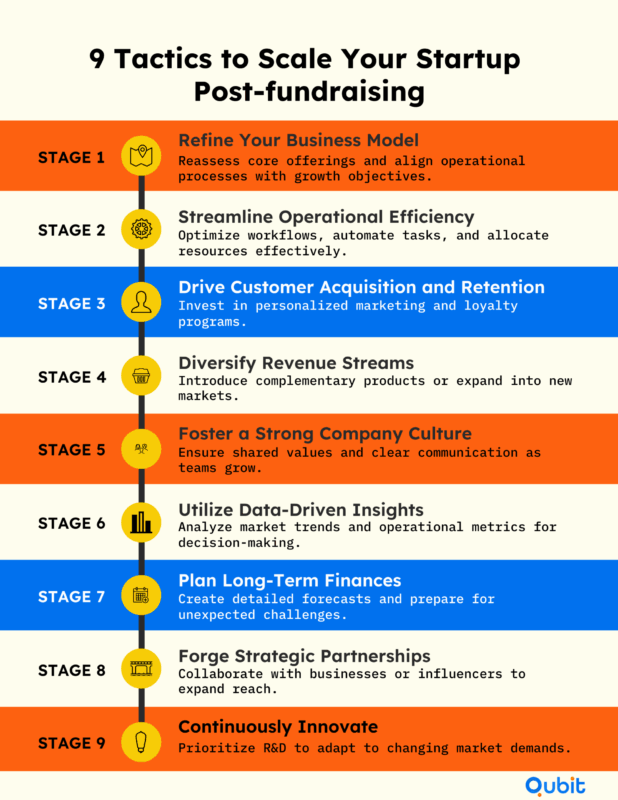Securing venture fundraising is a pivotal milestone for startups, but the real challenge lies in scaling operations effectively to sustain growth. With newfound capital, founders must prioritize strategic reinvestment to enhance startup profitability and operational efficiency. Developing a clear startup operations plan is a critical startup fundraising strategy for ensuring smooth transitions during post-funding growth. This blog will explore actionable strategies to help founders balance the complexities of scaling while maintaining financial health.
Nearly 88% of startup founders report cash flow concerns post-funding, highlighting the importance of meticulous planning. From optimizing workflows to aligning resources with growth goals, this guide will provide insights into building a sustainable framework for expansion. Let’s jump right in!
Strategic Operational Tactics for Scaling
Scaling operations after venture fundraising requires a thoughtful and adaptable strategy to ensure sustainable growth. This section explores the critical components of scaling, including refining business models, improving customer retention, and utilizing data analyses to optimize performance. By adopting a multifaceted approach, startups can position themselves for long-term profitability and success.

1. Refine Your Business Model
A well-defined business model is the backbone of scalable operations. Post-fundraising, startups should reassess their core offerings and identify areas for improvement. This includes enhancing value propositions to better meet customer needs and aligning operational processes with growth objectives.
2. Streamline Operational Efficiency
Efficiency is crucial for scaling. Startups should focus on optimizing workflows, automating repetitive tasks, and ensuring that resources are allocated effectively. This not only reduces costs but also enables teams to focus on strategic initiatives. Embedding data analytics into operations can fine-tune strategies and improve performance measurement.
3. Drive Customer Acquisition and Retention
Acquiring new customers is essential, but retaining them is equally important for sustainable growth. Startups should invest in personalized marketing strategies, robust customer support, and loyalty programs to build lasting relationships. Refining customer retention strategies not only boosts profitability but also creates a loyal user base that can advocate for the brand.
4. Diversify Revenue Streams
Relying on a single revenue source can limit growth potential. Diversifying income streams allows startups to mitigate risks and tap into new markets. This could involve introducing complementary products, exploring subscription models, or expanding into different geographic regions.
5. Foster a Strong Company Culture
A thriving company culture is integral to scaling. As teams grow, maintaining clear communication, shared values, and employee engagement becomes critical. A positive culture not only attracts top talent but also ensures alignment with organizational goals.
6. Utilize Data-Driven Insights
Data is a powerful tool for scaling. By analyzing customer behavior, market trends, and operational metrics, startups can make informed decisions that drive growth.
7. Plan Long-Term Finances
Financial planning is essential for scaling. Startups should create detailed forecasts, allocate budgets strategically, and prepare for unexpected challenges. This ensures that resources are available to support growth initiatives without compromising stability.
8. Forge Strategic Partnerships
Collaborations can accelerate scaling efforts. Partnering with established businesses, industry influencers, or complementary startups can open new opportunities and expand market reach. Strategic alliances also provide access to shared resources and expertise.
9. Continuously Innovate
Innovation is the driving force behind successful scaling. Startups should prioritize research and development to stay ahead of competitors and adapt to changing market demands. Continuous improvement ensures that products and services remain relevant and valuable to customers.
Scaling operations after venture fundraising requires a balanced approach that combines strategic planning, operational efficiency, and customer-centric initiatives. By refining business models, improving retention strategies, and utilizing data-driven insights, startups can achieve sustainable growth and long-term profitability.
Streamlined Scaling Insights
Scaling a startup is often as much about refining internal processes as it is about external growth. For startups experiencing rapid expansion, enhancing structural processes and streamlining operations are essential to sustain momentum. Without these foundational improvements, even the most promising ventures risk being overwhelmed by inefficiencies.
Building Operational Resilience
To support rapid growth, startups must focus on creating scalable systems that can handle increased demand without compromising quality. This includes automating repetitive tasks, optimizing workflows, and ensuring that teams are aligned with clear objectives. For example, startups transitioning to a revenue-centric model often find that balancing operational efficiency with customer acquisition strategies leads to sustainable scaling. This approach not only strengthens financial health but also fosters a positive company culture, as highlighted in the "Revenue-Centric Transition" trend.
Addressing Bottlenecks for Seamless Growth
Identifying and eliminating bottlenecks is another critical step in scaling efficiently. Bottlenecks can occur in various areas, such as supply chains, decision-making processes, or even team communication. Left unaddressed, these obstacles can slow down progress and frustrate both employees and customers. Startups that prioritize proactive problem-solving and adopt flexible operational frameworks are better equipped to handle the complexities of scaling.
Strong corporate governance in startups plays a vital role in this process. By implementing robust governance structures, startups can build investor confidence while ensuring that their operational frameworks are designed for scalable growth.
Streamlining for Success
Operational streamlining is not just about cutting costs; it’s about creating a system that works smarter, not harder. Startups that recalibrate their focus to integrate robust revenue models with their scaling strategies, as seen during the "2021 Fundraising Surge," are better positioned to thrive. This recalibration often involves adopting tools and technologies that enhance productivity while reducing redundancies.
By addressing these operational challenges head-on, startups can transition from reactive to proactive scaling strategies. This shift not only ensures smoother growth but also positions the company for long-term profitability and success.
Optimizing Core Business Operations
Securing funding often takes center stage for startups, but maintaining strong operational foundations is equally critical. Early-stage companies frequently prioritize venture fundraising over achieving startup profitability, which can lead to imbalanced growth strategies. While raising capital is essential, neglecting operational efficiency can hinder scalability and long-term sustainability.
Investor expectations often amplify this challenge. Pressure to meet short-term fundraising metrics can shift focus away from building robust operational systems that support profitability and scalability. This dynamic can create a cycle where startups chase funding rounds without addressing inefficiencies in their core business processes.
Balancing Fundraising and Operational Goals
Striking the right balance between fundraising and operational excellence requires intentional strategies. Mentorship programs and strategic networks play a pivotal role in guiding startups through these competing priorities. Experienced mentors can help founders align their fundraising efforts with operational goals, ensuring that profitability remains a central focus. Similarly, strategic networks provide access to industry insights and resources that can streamline operations while supporting growth.
The Role of Profitability in Scaling
Profitability is not just a financial metric; it’s a foundation for sustainable scaling. Startups that prioritize operational efficiency early on are better equipped to handle rapid growth when funding is secured. By optimizing processes and addressing inefficiencies, companies can reduce costs, improve product delivery, and enhance customer satisfaction—all of which contribute to long-term success.
For startups aiming to scale effectively, operational optimization should be viewed as an investment rather than an afterthought. Balancing profitability with fundraising efforts ensures that growth is both achievable and sustainable.
Tactical Post-Fundraising Implementation
Reinvesting venture fundraising capital effectively is the cornerstone of sustainable startup scaling. To maximize the impact of newly acquired funds, startups should prioritize technology upgrades and talent acquisition—two areas that directly contribute to operational growth and profitability.
1. Technology Upgrades: Enhancing Operational Efficiency
Investing in advanced technology tools can streamline workflows, improve product offerings, and enhance customer experiences. Startups should evaluate their current tech stack and identify gaps that hinder scalability. For instance, integrating data-driven platforms like Qualtrics Survey can help startups benchmark financial challenges and adjust growth strategies effectively. According to a survey of 250 startup founders, nearly 88% expressed concerns about the fundraising environment, citing a lack of operating cash as a top challenge. Tools like these enable startups to make informed decisions and optimize resource allocation.
Additionally, startups can explore automation solutions to reduce manual workloads and improve efficiency. Whether it’s upgrading CRM systems or adopting AI-powered analytics tools, technology investments should align with the company’s long-term scaling goals.
2. Talent Acquisition: Building a Robust Team
Post-funding, startups often face the challenge of scaling operations while maintaining quality. Recruiting top talent is essential to address this challenge. Founders should focus on hiring individuals with expertise in areas critical to growth, such as product development, marketing, and customer success. Remote hiring, as highlighted in the Qualtrics Survey, is becoming a viable option for startups aiming to expand their talent pool without geographical constraints.
To attract skilled professionals, startups can offer competitive packages and emphasize their growth potential. A well-rounded team not only drives innovation but also ensures operational stability during scaling phases.
Balancing Investments for Long-Term Success
While technology upgrades and talent acquisition are pivotal, startups must strike a balance between these investments and maintaining healthy cash flow. Avoiding common startup funding mistakes ensures startups can allocate resources effectively for scaling operations. By adopting fundraising best practices for startups, founders can ensure continued operational success while scaling post-funding.
Using Collaborative Networks for Operational Excellence
Scaling operations goes beyond internal adjustments. It involves building connections with industry peers, partners, and customers. Collaborative networks offer access to fresh perspectives, expert advice, and shared resources. This approach strengthens operations and opens new avenues for sustainable growth.
Fostering relationships with external stakeholders can help overcome challenges. By gathering diverse insights, startups can identify opportunities that might remain hidden within isolated teams. Regular dialogue with collaborators also creates an environment where constructive feedback leads to continuous improvements.
Consider these strategies to maximize collaborative benefits:
- Engage with Industry Peers: Exchange best practices and lessons learned.
- Partner with Specialists: Utilize expert guidance for targeted problem-solving.
- Establish Customer Advisory Boards: Gain direct input on product and service enhancements.
- Form Strategic Alliances: Create partnerships that expand market reach and resource sharing.
Short, focused meetings and periodic reviews with these groups can streamline decision-making and boost efficiency. Clear communication channels help ensure that insights translate into actionable plans. Building a robust external network provides the startup with a competitive edge while reinforcing operational resilience.
This network approach enables rapid responses to market shifts and internal bottlenecks, ensuring that the company remains agile and well-equipped to meet evolving growth challenges.
Conclusion
Sustainable growth requires a thoughtful approach, balancing innovation with operational excellence. Recapping the strategies discussed, maintaining core business functions ensures stability, while adopting multifaceted operational tactics and streamlined process enhancements drive efficiency. Reinvesting wisely post-funding is critical for scaling effectively.
Equally important is developing a clear, narrative-driven strategy that resonates with stakeholders. Operational clarity builds trust and sets the stage for long-term success. These principles empower businesses to make informed decisions and take actionable steps toward lasting growth.
If you're ready to refine your growth strategy with a compelling narrative, we at Qubit Capital can help with our end-to-end Fundraising Assistance service. Contact us to get started.
Key Takeaways
- Balancing aggressive fundraising with operational efficiency is critical for long-term success.
- Focusing on vital business functions helps maintain startup profitability.
- A multifaceted, data-driven strategy is essential for scalable growth post-funding.
- Streamlined processes and the elimination of bottlenecks drive rapid scaling.
- Post-fundraising reinvestment in technology and talent is imperative for sustainable operational excellence.
Frequently asked Questions
How do you transition into investor relations?
• Begin by establishing clear communication channels with current investors.
• Develop an investor relations strategy that includes regular updates and transparent reporting.
• Leverage data insights to present your operational progress and future plans.
• Build trust by addressing concerns proactively. This approach helps in seamlessly transitioning and maintaining strong investor relationships.


 Back
Back



